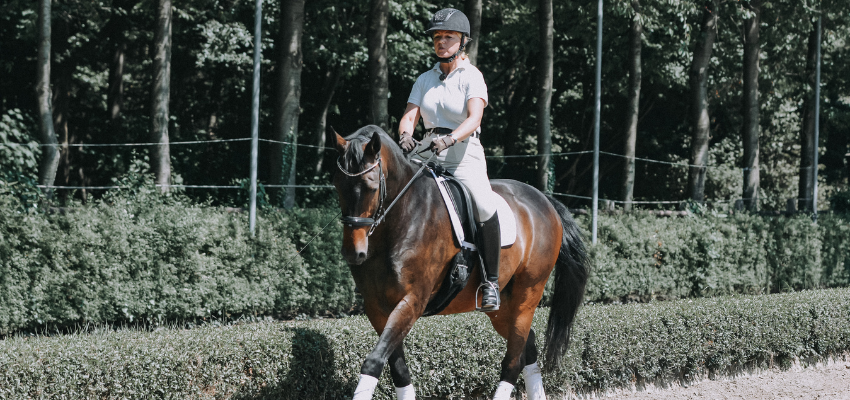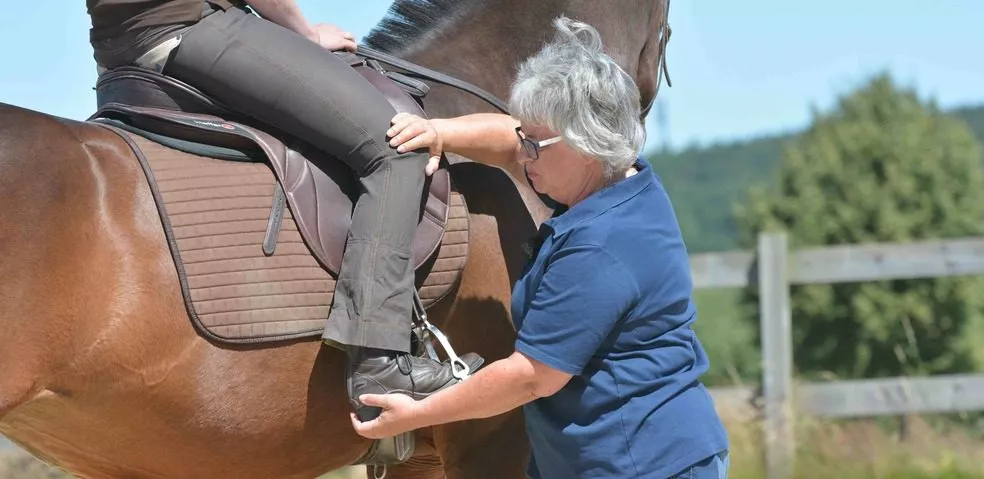The effect of integrating riding specific exercises into your fitness program, or just doing it once or twice a week as your fitness program, will yield fabulous results. Many riders such as Eventing Champion Bettina Hoy and Dressage Champion Jessica von Bredow-Werndl uses fitness training for improving performance in the saddle.
What are the benefits of fitness training for equestrians?
The first big bonus, whether you ride just for fun or want to improve your scores in the dressage arena; an improved, stronger, balanced and secure position in the saddle.
- You want to be able to follow the movement of your horse more easily?
- To be able to sit to the trot without bouncing?
Bettina Hoy has exercises that will help you. Another big advantage to be had is quieter hands, a result of increased core stability, with the ability to give finer aids, resulting in an overall better feeling in the saddle and a far more harmonic picture. This is all a possibility simply by integrating these equestrian specific exercises into your time spent at the stable. We will show you exercises to help you get started, whatever your fitness level! Fitness training dedicated to equestrians is a growing trend among riders of all levels: those who complement their training in the saddle with specific fitness exercises can see a real difference while riding! Training your balance, mobility and musculature not only helps you be more precise in the saddle but also decreases the risk of injury while riding.
Why Cross-Fit makes you a better rider?
You may think `Oh, I do not have enough time to go the gym´ but the bonus of training developed by a rider is they understand this and show us all the exercises, firstly in a gym setting and then in the stable. Using equipment everyone has, a rail and lead rope for pull ups, a stable fork or broom for shoulder exercises, even just taking water to your horse can become a workout! This doesn't mean hours every day either, working out twice a week for 15-20 minutes is enough to see an improvement in your riding.
The same way horses have a natural crookedness, so do the majority of riders (that pesky inside hand that has a life of it's own?) and the exercises here also help us improve our symmetry and coordination, meaning not only can we overcome that pesky inside hand but means we can better help our horses crookedness, both natural and rider related. There are targeted exercises that enable us to improve our flexibility and stability in the saddle, with an improvement in our overall balance. For someone riding a green or spooky horse, this can make riding enjoyable again and a whole lot safer.
Self-awareness and increased control of your own body and muscles is a great way to achieve an independent seat, meaning finer, more precise and effective use of the aids. Being able to synchronize your leg, weight and rein aids means a happier and most likely, more willing, horse that better understands your aids and what you are asking, meaning a more successful and above all, more harmonic partnership with your horse.
Keep in mind that everything you do helps. Even just a few minutes of warming-up before riding can make a difference. You will also see that the exercises get easier with time, you might find that carrying heavier weights or doing more repetitions gradually becomes easier.

Here are some exercises to get you started:
What are Shoulder Rotations?
This exercise helps you gain mobility and flexibility in your shoulders. This is perfect for riders that struggle to sit upright and will help you to ride with quiet, independent hands. Keep in mind for all exercises that you should take your time, you shouldn't feel pain, take it slowly and don't overdo it.
How to do it:
- Stand comfortably with feet shoulder width apart
- The hands hold on from above, to your bar, broomstick or fork - Arms outstretched throughout the exercise
- The tighter you grip the harder the exercise is.
What is there to know about the Mobility exercise?
Not only does this exercise helps you stretch your muscles but also prepares your ankle, knee and hip joints for work.
- Take a step forward with one leg
- Hands are placed either side of the forward foot
- Allow the front foot to move 90 degrees
- Push the hips forward and down and push the knee to the outside with your elbow
- It should be slightly uncomfortable, but should not get worse during or after the exercise
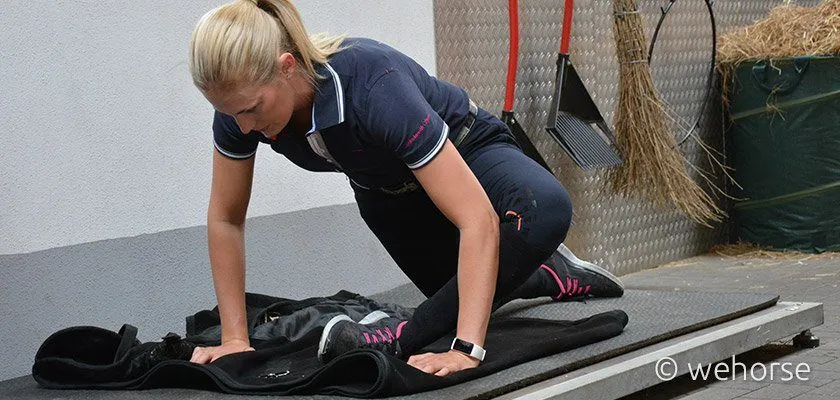
How to warm-up in the saddle?
This exercise by Sibylle Wiemer is not only simple but very effective. During the walk of your horse, you sit in the saddle with stirrups crossed in front of you: Swing one leg from the back to the front. The movement should start from your hip, not just the lower leg. This helps you gain mobility in the hips A good idea can be to get someone to lead your horse the first time you try this, just until you're sure he's not worried! "Usually riders find it difficult to move one leg more than the other," says Sibylle Wiemer (this points to our own crookedness, making cross-fit and general rider fitness exercises such a good idea).
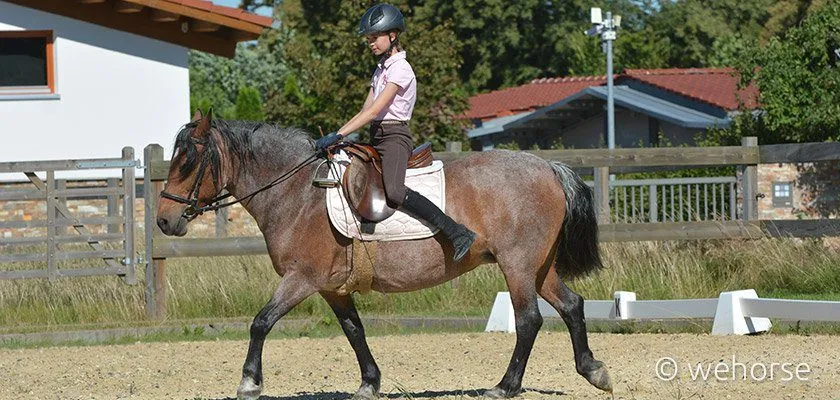
Bring variety in your own fitness training
"If you want your horse to move like a rubber ball, you have to become a rubber ball yourself." Dressage trainers Jessica von Bredow-Werndl and Benjamin Werndl also believe in the benefits of a holistic approach. Strength, endurance, yoga and mental training are all part of their training.
Special attention is paid to the core muscles - a strong back is important, because long term most riders suffer from back problems. If you want to be supple in the saddle, you have to be flexible and be able to tighten and relax specific muscles at will. Yoga is ideal for improving these skills. Jessica von Bredow-Werndl shows how she practises yoga and explains what mental exercises are helpful to her before and during the competition. As equestrians, we should not only prepare and expect our horse to be fit but also be prepared to incorporate workouts and maintain our own fitness to support them in their everyday training as well as in competition.
The fitness of the rider is very often underestimated, by non-riders as well as by active ones. But this is where the real potential lies: Whoever prepares his body well for riding can make progress in the saddle. This applies to every level of performance. This aspect is very important for the overall training of equestrian siblings Jessica von Bredow-Werndl and Benjamin Werndl.
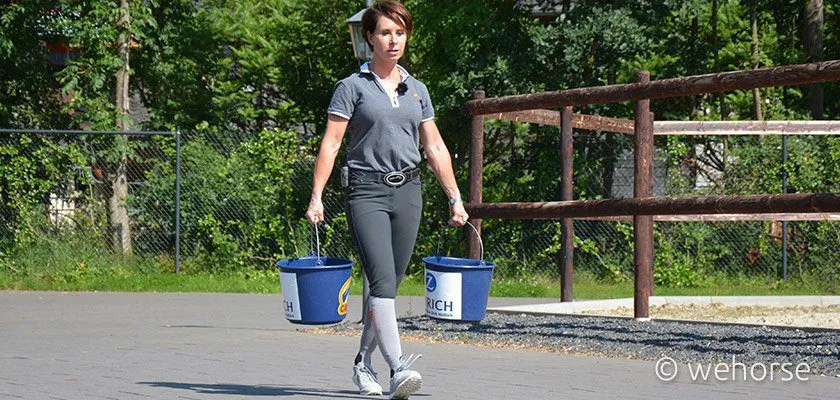
How to train your own fitness at the stables?
You don't need specific fitness training material!
All of the exercises that are seen can be practiced in the stables with very few accessories. As an example, you can practice lifting weights simply by using buckets of water. Bettina Hoy shows you what should be taken into consideration to avoid hurting your back (and avoid getting wet!)
`You do not need to go to a studio, you can do the exercises just as easily at the barn.´ Bettina Hoy is not only convinced of this, she does it too. She shows you how you can easily apply each exercise at the stables and turn it into an everyday routine.
Keep in mind: every single effort counts! Get started and see for yourself!


